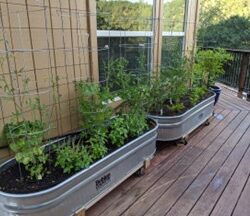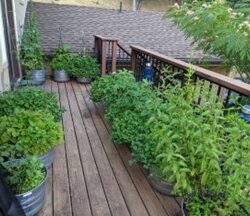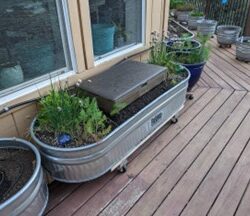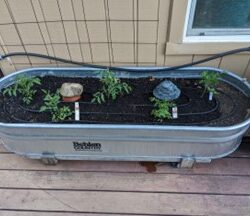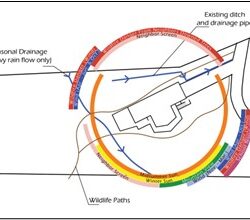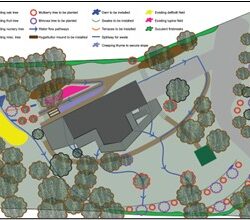Can you create a food forest in a fire prone area without risking your home?
I’ve been fascinated by permaculture since I first learned of it about 10 years ago from a friend. Specifically, the idea of building a diverse and permanent food forest that will become stable and maintain itself over time is what initially drew me in all those years ago.
For those that don’t already know what permaculture is, I’ve provided the definition below as coined by Bill Mollison.
Permaculture (permanent agriculture) is the conscious design and maintenance of agriculturally productive ecosystems which have the diversity, stability, and resilience of natural ecosystems. It is the harmonious integration of landscape and people providing their food, energy, shelter, and other material and non-material needs in a sustainable way.
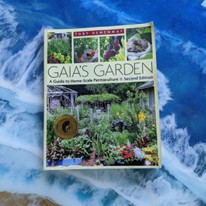

 I’ve been practicing permaculture in earnest since July of 2020, when the same friend loaned me his book called Gaia’s Garden written by Toby Hemenway. Shortly after finishing the book I decided to start with zone 1 and build myself a small kitchen garden on my deck, just outside my door. I knew enough to know that I didn’t know much, so I focused on getting the raised garden beds up and producing before I ventured out into any of the other permaculture design ideas that I had swirling around in my head. I chose to use metal watering troughs as raised garden beds and connected them to a drip watering system to keep my new plant babies hydrated.
I’ve been practicing permaculture in earnest since July of 2020, when the same friend loaned me his book called Gaia’s Garden written by Toby Hemenway. Shortly after finishing the book I decided to start with zone 1 and build myself a small kitchen garden on my deck, just outside my door. I knew enough to know that I didn’t know much, so I focused on getting the raised garden beds up and producing before I ventured out into any of the other permaculture design ideas that I had swirling around in my head. I chose to use metal watering troughs as raised garden beds and connected them to a drip watering system to keep my new plant babies hydrated.
When the kitchen garden was up and running I started to think about where I would create my food forest. I live on a highly sloped 2.5 acres and was struggling to determine the best place for the new nursery trees, so I decided to find a Permaculture Design Course (PDC) that would help me gain the knowledge that I was seeking.
In January 2021 I enrolled in Geoff Lawton’s online PDC. It took me more than a year and a half to get through all of the course material and create my final design exercise (FDE). The FDE was a permaculture design on the property of our choosing (I chose my own property) that included the completion of a 52 page property detail form and 11 maps.
During my PDC, the River Fire (Aug. 2021) came within miles of my home in Grass Valley and I realized just how critical it was for me to take fire into account in my final design*. I chose to keep the downhill slope (southeast) fairly sparse with two swales to keep things hydrated and a succulent border as a fire break. Upslope (north) I chose another succulent border as a fire break with a dam at the top of the drainage to supply fire sprinklers. In August of 2022, I finally received my Permaculture Design Certificate!
*My sector and final design maps for reference
I was so excited to get started building my food forest and implement the rest of my design plan. I fenced in a couple of the trees that I had already planted months ago on the northwest corner of my property in anticipation of planting the other 6 layers of my food forest.
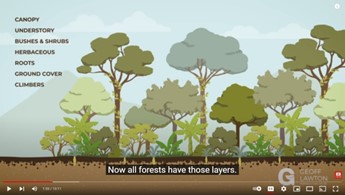


Watch Geoff Lawton’s video on the 7 different layers of a food forest and how valuable they are to the future of humanity.
Just one month later, my neighboring County endured their largest wildfire in history, so firescaping and my duty to keep defensible space around my forested home was top of mind. I chose to attend a lunch time workshop on firescaping, taught by Master Gardener Kevin Marini, to learn how I could better protect my home.
Kevin stressed the importance of removing fire ladders by keeping tall trees trimmed up 6 feet and removing shrubs and other vegetation below trees. The longer he talked the more anxious I became because I felt like he was essentially saying that a food forest was a fire hazard. My food forest dreams were crushed!
After a few days of sulking I decided to do some more research and find an answer to the question, how can I create a food forest in a fire prone area without risking my home? Here’s what I’ve come up with so far.
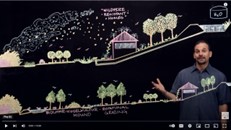


After joining a few local permaculture Facebook groups and asking them my question, I received a few answers. First I was pointed towards this YouTube video created by Andrew Millison called Permaculture Design for Wildfire Defense. He stressed the importance of assessing the property for fire danger to begin with so that you will know where your fire sector is located and therefore where fire breaks should be located.
In the video he also discusses only having tall large leafed trees for shade and food production near the home, but with no vegetation below them to remove the risk of a fire ladder. He then talks about elements that could be placed in the fire sector and used as fire breaks.
He didn’t specifically mention food forests, but he did say that having an irrigated orchard in the fire sector could provide a good fire break. Unfortunately, I wasn’t overly satisfied with that answer because it still sounds like a permaculture food forest isn’t possible due to the ladder fuel potential.
The second answer I received came from a local company called Practical Permaculture. Their suggestion was to spread out the levels of the food forest horizontally, which would allow for better maintenance. They also stated that not every design technique is appropriate for every climate. From that I understood that a food forest may not be the best idea for my fire prone area.
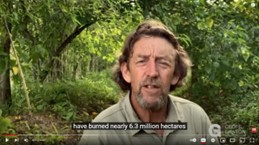


The third piece of information I considered was a YouTube video created by Geoff Lawton called How to Make Your Property Fire Resistant with Permaculture Design. He detailed five different strategies:
- Capture ALL of your rainwater
- Create head pressure
- Maintain open areas
- Infiltrate water into your soil and use hard surface runoff
- Plant fire-resistant species
The video doesn’t discuss food forests specifically, but he does mention that the well hydrated swale areas, where I believe his food forest is located, are helpful in saving a property from an advancing bush fire.
I will continue my research on this topic because I dream of having a thriving food forest on my property some day. In the meantime this is the plan that I have come up with:
- Dig swales and plant some well spaced nursery trees in the non fire sector area of my property
- New swale area will be outside of the 100 foot defensible space buffer
- Keep swales watered during the summer months so that the vegetation doesn’t dry out and create fuel
- Maintain the swale area so that fuel doesn’t build up
- Plant out planned succulent borders as a fire break
- Build the planned pond to capture water runoff and provide water for fire fighting efforts
I’d love to hear from other experts in the local area who have also thought about this topic and have some ideas on how we can make food forests work for us. I’ve created a group for discussions like this called the Earth Warriors within a larger community called The Warrior’s Network. I invite you to join me there to meet other like minded people and discuss ways that we can all be more beneficial humans. If we all focus on solutions together there is nothing that we can’t accomplish.
Cynthia Soszka
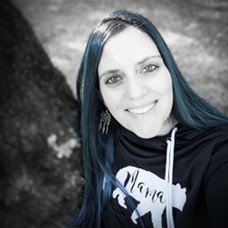

 Cynthia Soszka is committed to finding solutions for the global environmental issues we’re all facing today. She’s currently focused on permaculture as a solution, and is always searching for new ways to become a more beneficial human.
Cynthia Soszka is committed to finding solutions for the global environmental issues we’re all facing today. She’s currently focused on permaculture as a solution, and is always searching for new ways to become a more beneficial human.
She graduated from UC Davis with a degree in Environmental Resource Science and worked as a biologist for many years before coming in out of the field and working for her local government.
She’s been practicing permaculture since July of 2020 and recently received her Permaculture Design Certificate from Geoff Lawton’s online PDC in August of 2022. She’s also the creator of The Warrior’s Network and has owned her own business since 2017 where she goes by the Serenity Warrior Mama. If you’re interested in becoming a more beneficial human, please visit the Earth Warriors group and check out her free 7-Day Beneficial Human Workshop.






